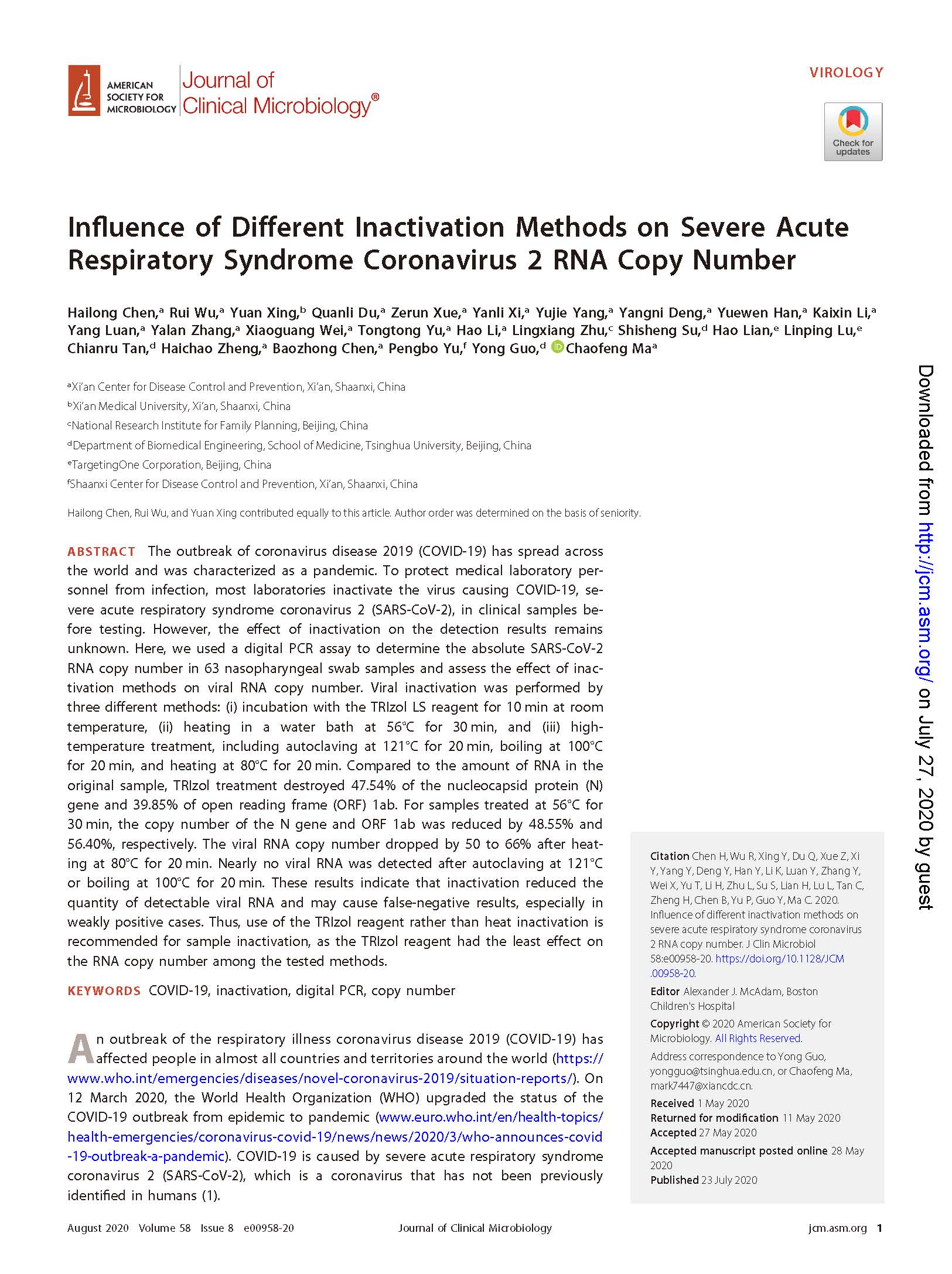release date:2020-07-23
 The outbreak of coronavirus disease 2019 (COVID-19) has spread across the world and was characterized as a pandemic. To protect medical laboratory per-sonnel from infection, most laboratories inactivate the virus causing COVID-19, se-vere acute respiratory syndrome coronavirus 2 (SARS-CoV-2), in clinical samples be-fore testing. However, the effect of inactivation on the detection results remains unknown. Here, we used a digital PCR assay to determine the absolute SARS-CoV-2 RNA copy number in 63 nasopharyngeal swab samples and assess the effect of inac-tivation methods on viral RNA copy number. Viral inactivation was performed by three different methods: (i) incubation with the TRIzol LS reagent for 10 min at room temperature, (ii) heating in a water bath at 56°C for 30 min, and (iii) high-temperature treatment, including autoclaving at 121°C for 20 min, boiling at 100°C for 20 min, and heating at 80°C for 20 min. Compared to the amount of RNA in the original sample, TRIzol treatment destroyed 47.54% of the nucleocapsid protein (N) gene and 39.85% of open reading frame (ORF) 1ab. For samples treated at 56°C for 30 min, the copy number of the N gene and ORF 1ab was reduced by 48.55% and 56.40%, respectively. The viral RNA copy number dropped by 50 to 66% after heat-ing at 80°C for 20 min. Nearly no viral RNA was detected after autoclaving at 121°C or boiling at 100°C for 20 min. These results indicate that inactivation reduced the quantity of detectable viral RNA and may cause false-negative results, especially in weakly positive cases. Thus, use of the TRIzol reagent rather than heat inactivation is recommended for sample inactivation, as the TRIzol reagent had the least effect on the RNA copy number among the tested methods.
The outbreak of coronavirus disease 2019 (COVID-19) has spread across the world and was characterized as a pandemic. To protect medical laboratory per-sonnel from infection, most laboratories inactivate the virus causing COVID-19, se-vere acute respiratory syndrome coronavirus 2 (SARS-CoV-2), in clinical samples be-fore testing. However, the effect of inactivation on the detection results remains unknown. Here, we used a digital PCR assay to determine the absolute SARS-CoV-2 RNA copy number in 63 nasopharyngeal swab samples and assess the effect of inac-tivation methods on viral RNA copy number. Viral inactivation was performed by three different methods: (i) incubation with the TRIzol LS reagent for 10 min at room temperature, (ii) heating in a water bath at 56°C for 30 min, and (iii) high-temperature treatment, including autoclaving at 121°C for 20 min, boiling at 100°C for 20 min, and heating at 80°C for 20 min. Compared to the amount of RNA in the original sample, TRIzol treatment destroyed 47.54% of the nucleocapsid protein (N) gene and 39.85% of open reading frame (ORF) 1ab. For samples treated at 56°C for 30 min, the copy number of the N gene and ORF 1ab was reduced by 48.55% and 56.40%, respectively. The viral RNA copy number dropped by 50 to 66% after heat-ing at 80°C for 20 min. Nearly no viral RNA was detected after autoclaving at 121°C or boiling at 100°C for 20 min. These results indicate that inactivation reduced the quantity of detectable viral RNA and may cause false-negative results, especially in weakly positive cases. Thus, use of the TRIzol reagent rather than heat inactivation is recommended for sample inactivation, as the TRIzol reagent had the least effect on the RNA copy number among the tested methods.KEYWORDS COVID-19, inactivation, digital PCR, copy number
See all: https://jcm.asm.org/content/58/8/e00958-20